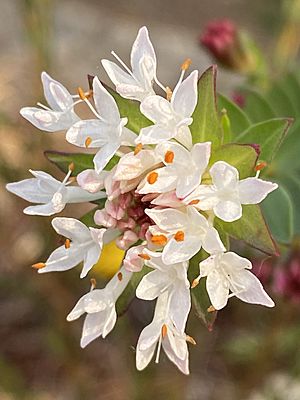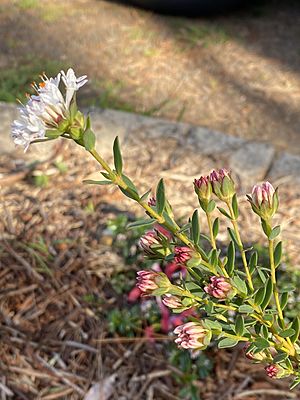White banjine facts for kids
Quick facts for kids White banjine |
|
|---|---|
 |
|
| Scientific classification | |
| Genus: |
Pimelea
|
| Species: |
ciliata
|
The Pimelea ciliata, also known as white banjine, is a type of flowering plant. It belongs to the plant family called Thymelaeaceae. This plant is a small shrub with pretty white flowers. It is special because it is only found in Western Australia.
Contents
What is White Banjine Like?
A Small Shrub with Unique Leaves
The white banjine is a small shrub. It usually grows to be about 0.5 to 1 meter (1.5 to 3 feet) tall. Its leaves can be long and narrow, or shaped like an egg. They are typically 5 to 22 millimeters (0.2 to 0.9 inches) long. The leaves are about 1.5 to 7 millimeters (0.06 to 0.28 inches) wide. Sometimes, the edges of the leaves curl a little. Each leaf sits on a short stalk, about 1 millimeter long, and has a pointed tip.
How Its Leaves Grow
The leaves of the white banjine are arranged in a cool way. They grow in pairs, with each pair at a right angle to the pair above and below it. This makes the leaves form four neat rows along the stems. The top side of the leaves is darker than the underside. When the stems are young, they are orange-red or brownish. As they get older, they turn grey.
Beautiful White Flowers
The white banjine has upright clusters of flowers. These flowers are usually light pink or white. Each flower has a smooth inside. They grow on small stalks, about 1 to 2 millimeters long. Around the flowers, there are four to six special egg-shaped leaves called bracts. These bracts are 8 to 13 millimeters long and 5 to 10 millimeters wide. They have tiny hairs along their edges. The parts of the flower that make pollen (stamens) are often a bit longer than the outer leaf-like parts (sepals). You can see these flowers blooming from August to December.
Where Does White Banjine Grow?
Its Home in Western Australia
The white banjine grows in the southwest part of Western Australia. You can find it in areas near Bindoon. It also grows south to Margaret River and southeast to the Porongurup Range. This plant prefers to grow on hills and rocky areas. It can grow in different types of soil, including clay, sand, loam, and soils with granite or laterite.
How White Banjine Got Its Name
Naming the White Banjine
The scientific name Pimelea ciliata was first officially described in 1984. This was done by a scientist named Barbara Lynette Rye. She published her description in a science journal called Nuytsia.


